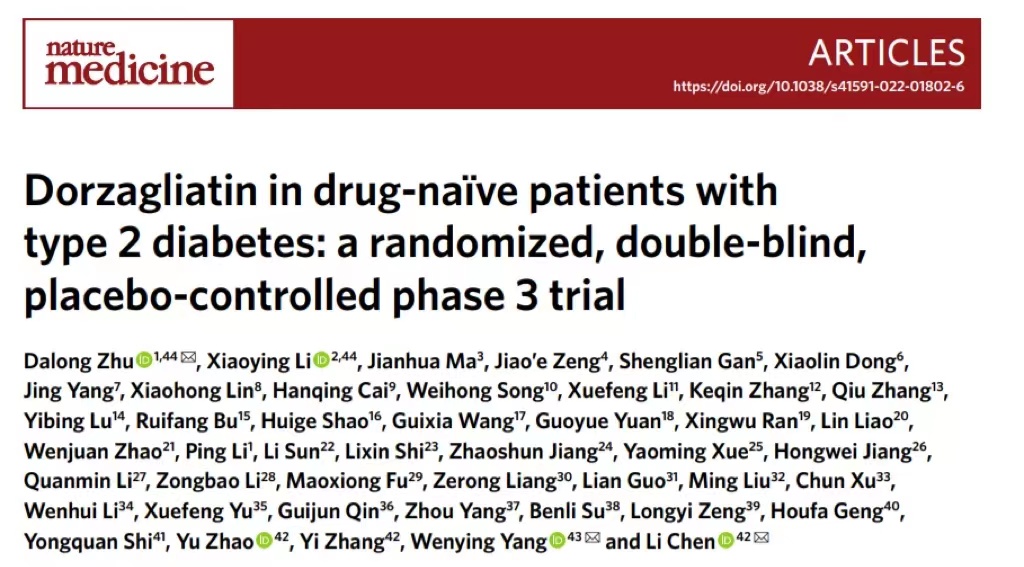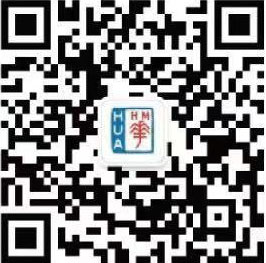



Media
Hua Medicine Published Two Peer-Reviewed Papers in Nature Medicine, an International Top Medical Journal, on the Results of the Phase III Research of Dorzagliatin, a First-In-Class Investigational Diabetes Drug of Hua Medicine



May 13, 2022, Shanghai, China
Hua Medicine (the "Company", stock code on the main board of the Hong Kong Stock Exchange: 2552.HK) today announces that, two peer-reviewed papers on the Phase III clinical trial results of dorzagliatin, a glucokinase activator (GKA) and first-in-class investigational drug of the Company for the treatment of diabetes, were published online simultaneously by Nature Medicine, an international top medical journal. These two papers described and analyzed the clinical efficacy and safety characteristics of dorzagliatin monotherapy (SEED) in drug-naïve Type 2 diabetes (T2D) patients and the combination therapy of dorzagliatin and metformin (DAWN) in patients who failed in metformin adequacy therapy for the treatment of T2D respectively.


It was the first time for Nature Medicine to publish the results of Phase III trials of a GKA, representing the results of large registered clinical studies in China. Dorzagliatin is a new first-in-class GKA antidiabetic drug to successfully complete the Phase III registered clinical study in the world, which was led by Chinese researchers. The two papers are also the first to be published in Nature Medicine with Chinese researchers as the first and corresponding authors of a novel mechanism for treatment of diabetes. Both studies demonstrated that by addressing the defect of the glucose sensor function of glucokinase (GK), dorzagliatin is able to continuously and effectively reduce HbA1c in patients with T2D, and significantly reduce post-meal glucose (2h-PPG) during the treatment period. The percentage of patients admninistered dorzagliatin achieving standard glycemic blood glucose control was demonstrated to be high and with low hypoglycemia incidences. It was also shown that dorzagliatin has good safety and tolerability. In addition, it can continuously improve β-cell function and reduce insulin resistance.
Dorzagliatin is the first-in-class oral drug developed by Hua Medicine for the treatment of T2D after 10 years of independent research and development, which identifies GK as a therapeutic target. GK plays a critical role in maintaining blood glucose homeostasis in human body, serving as a glucose sensor to sense changes of the blood glucose, and timely stimulates glucose control organs to secrete insulin, GLP-1 or glucagon, so as to effectively regulate blood glucose level and maintain blood glucose homeostasis (4-6.5 mmol/L). Impaired sensitivity of glucose, mainly manifested as impaired glucose stimulated insulin secretion (GSIS) function of pancreatic β-cells and rise of FPG level blood sugar fluctuations, is the root cause of T2D. Dorzagliatin can act on GK in glucose control organs such as pancreas, liver and intestine. By restoring GK activity in T2D patients, it helps restore the sensitivity of the human body to blood glucose changes, and thus improves the early phase insulin secretion and β-cell function. In this way, blood glucose homeostasis can be rebuilt to control or delay the progression of T2D, and fundamentally treat diabetes and discontinue medication. Hua Medicine has published over 10 papers on the results of basic and clinical studies to continually elaborate its scientific concept of "restoring sensitivity, rebuilding homeostasis, and treating diabetes at its source". The results of the Phase III trial published by Nature Medicine are the clinical validation of this innovative concept. In March 2021, Hua Medicine submitted the new drug application (NDA) of dorzagliatin to the China National Medical Products Administration (NMPA) for T2D treatment, which was accepted in April. Currently, the NDA of dorzagliatin is under active review by the NMPA. Hua Medicine is fully supporting this process to obtain the approval of dorzagliatin as early as possible.
Nature Medicine is a top journal, focusing on the field of biomedicine. It mainly publishes original research papers that “demonstrate novel insight into disease processes, with direct evidence of the physiological relevance of the results”, and has begun to focus on publishing papers of large clinical research in recent years. The impact factor of Nature Medicine has been on the rise. With a 2-year impact factor of 53.44, it has surpassed Nature to be one of the top five medical journals, also including The New England Journal of Medicine (NEJM), The Lancet, The Journal of the American Medical Association (JAMA) and The British Medical Journal (BMJ), known traditionally as four medical journals. Since 2009, Franz Matschinsky, the father of GK, first reported the research and development of GKA in Nature Reviews Drug Discovery, the theoretical research and drug research and development results related to GKA have drawn worldwide attention, and have been highly valued by the international academic and clinical medical communities. Before, the results of the Phase II clinical trial of dorzagliatin were published in the advanced medical journal The Lancet Diabetes and Endocrinology. Since 2014, Hua Medicine has been presenting the results of basic researches and clinical studies of dorzagliatin at the world’s largest and most important diabetes conference - the American Diabetes Association (ADA) Scientific Sessions every year. It was through the ADA Scientific Sessions that the editors of Nature Medicine noticed the innovativeness and breakthrough nature of dorzagliatin, and took the initiative to make an appointment with Hua Medicine for scripts. These two newly published papers present the Phase III results of the SEED study and the DAWN study of dorzagliatin, respectively.
The SEED study is a study of dorzagliatin monotherapy. It is a randomized, double-blind and placebo-controlled Phase III registered clinical study in drug naïve T2D patients. The study was conducted among 463 T2D patients. The first 24 weeks were randomized, double-blind and placebo-controlled treatment, designed to evalsuate the primary efficacy and safety endpoints of dorzagliatin. The subsequent 28 weeks were open-label period for dorzagliatin, designed to continuously observe and evalsuate the safety of dorzagliatin. The SEED study was led by Professor Dalong Zhu, the President of the Chinese Diabetes Society, and Director of Medical Center for Endocrine and Metabolic Diseases of Drum Tower Hospital, affiliated to Medical School of Nanjing University. This study showed that dorzagliatin can effectively reduce the blood glucose of drug naïve T2D patients, with good safety and tolerability. The main conclusions of the SEED study include:
Significant and long-lasting efficacy:
● There was a 1.07% HbA1c reduction from baseline in 24 weeks, significantly better than that of the placebo treated group (p<0.001)
● The standard-reaching rate of HbA1c was 42.5% in 24 weeks, significantly higher than that of the placebo treated group (p<0.001)
● Significantly improved β cell function, with a 3.28 increase in HOMA2-β in 24 weeks compared with the placebo treated group
● The 2h-PPG observably decreased by 2.33mmol/L compared with the placebo treated group in 24 weeks
● The FPG observably decreased by 0.33mmol/L compared with the placebo treated group in 24 weeks
● The HbA1c continued to remain steady in 52 weeks
Good tolerability and safety:
● The hypoglycemia (<3mmol/L) incidence rate was less than 1% in 24 weeks, and there was no severe hypoglycemia reported
● The hypoglycemia (<3mmol/L) incidence rate was less than 1% in 52 weeks, and there was no severe hypoglycemia reported
● In 52 weeks, there was no drug-related SAE
The DAWN study is a randomized, double-blind, placebo-controlled Phase III study among 767 patients, which uses dorzagliatin combined with metformin to treat T2D patients who failed in metformin adequacy therapy. The first 24 weeks were randomized, double-blind and placebo-controlled treatment, designed to evalsuate the primary efficacy and safety endpoints of dorzagliatin. The subsequent 28 weeks were open-label period for dorzagliatin, designed to continuously observe and evalsuate the safety of dorzagliatin. The DAWN study was led by Professor Wenying Yang at China-Japan Friendship Hospital, who is the former President of the Chinese Diabetes Society and present Vice President of the Asian Diabetes Association. This study showed that dorzagliatin can effectively reduce the blood glucose of T2D patients who failed in metformin adequacy therapy, with good safety and tolerability. The main conclusions of the DAWN study include:
Significant and long-lasting efficacy:
● The HbA1c reduction was 1.02% from baseline, significantly better than that of the placebo treated group in 24 weeks
● The standard-reaching rate of HbA1c was 44.4% in 24 weeks, significantly higher than 10.7%(p<0.0001) in the placebo treated group
● Significantly improved β cell function and HOMA2-β increased by 2.43 compared with the placebo treated group in 24 weeks
● The 2h-PPG observably decreased by 2.48mmol/L compared with the placebo treated group in 24 weeks
● The FPG observably decreased by 0.38mmol/L compared with the placebo treated group in 24 weeks
● The HbA1c continued to remain steady in 52 weeks
Good tolerability and safety:
● The hypoglycemia (<3mmol/L) incidence rate is less than 1% in 24 weeks, and there was no severe hypoglycemia reported
● The hypoglycemia (<3mmol/L) incidence was less than 1% in 52 weeks, and there was no severe hypoglycemia reported
● In 52 weeks, there was no drug-related SAE
Professor Dalong Zhu, the first author of the paper on SEED, said, "The investigator team of dorzagliatin and the R&D team of Hua Medicine have always focused on the clinical needs of patients and adhered to scientific rigor to successfully develop this first-in-class new drug together. The publication of the results of the two Phase III clinical studies on Nature Medicine is another proof of the international academic community recognizing China's new drug development capabilities. As a clinical investigator, I feel very proud and confident about the future of innovative drug development in China. In clinical trials, dorzagliatin has demonstrated long-lasting and stable efficacy, as well as good safety and tolerability. In the meanwhile, it showed significant potentiation in combination trials with SGLT-2 inhibitors and DPP-4 inhibitors. I am very much looking forward to bringing new treatment options with dorzagliatin to Chinese T2D patients soon."
Professor Xiaoying Li, the co-corresponding author of the paper and Director of the Department of Endocrinology at Zhongshan Hospital affiliated to Fudan University, said, "Nature Medicine is a top journal with a high impact factor. The clinical trial of dorzagliatin is designed in line with the standards of international multinational companies. All the investigators and developers followed a high bar of standards and quality, which led to the creation of such a high-value breakthrough drug. I’m very proud and excited about this achievement. Type 2 diabetes is a critical threat to human health. As clinicians, our involvement in the clinical development of dorzagliatin has given us the opportunity to review the regulating mechanisms of glucose homeostasis and to better understand the process and characteristics of the progression of type 2 diabetes. "
Professor Wenying Yang, the first author of the DAWN paper, said, "I am very excited and happy! Before, the results of Phase II clinical study of dorzagliatin were published in The Lancet Diabetes and Endocrinology, and now the results of Phase III clinical study were published in Nature Medicine. Such achievements are completely on par with the first-in-class diabetes drugs developed by multinational pharmaceutical companies. This is a great recognition on Chinese innovative drugs, the best return to Hua Medicine and Dr. Chen Li’s 10 years of hard work, and the most memorable experience for us as clinical investigators. We are fortunate to meet such a good pioneer. I look forward to the launch of dorzagliatin soon!"
Dr. Yi Zhang, Chief Medical Officer, Senior Vice President of Pharma Development of Hua Medicine and the head of clinical development for dorzagliatin, said, “The publication of the results of the two clinical studies, i.e., the SEED study and the DAWN study, on Nature Medicine fully demonstrated the scientific research capabilities of Chinese clinical researchers and Hua Medicine’s innovative R&D strengths as a China-based biopharmaceutical company. The Phase III clinical trial of dorzagliatin is the first confirmatory clinical study of GKA drugs completed worldwide. It is also the first clinical trial of a first-in-class investigational diabetes drug led by a Chinese clinical team with Chinese subjects as the research objects. We are very grateful to all clinical researchers for their unremitting efforts and hard work. In the future, Hua Medicine is confident to join hands with partners in various clinical fields to make new breakthroughs in the field of Type 2 diabetes and the whole metabolic diseases.”
Dr. Li Chen, Founder, CEO, Chief Scientific Officer of Hua Medicine and corresponding author of both papers, said, "We are very pleased to collaborate with Jennifer Sargent, Editor-in-Chief, to publish the clinical research results of dorzagliatin in Nature Medicine. This illustrates the strong interest and attention of the international medical community on the GK mechanism and GKA drugs. In 1968, Professor Franz Matschinsky, the father of glucokinase, discovered the critical role of GK in glucose-stimulated insulin secretion and proposed glucokinase as a diabetes gene and glucose sensor. The drug development of glucokinase activators has, since then, undergone numerous difficulties and failures. More than 50 years later, I am very pleased to see that Hua Medicine R&D team and Chinese clinical experts, after ten years of hard work, have overcome many R&D difficulties and greatly improved the understanding of glucokinase's role in the regulation of blood glucose homeostasis and diabetes treatment, established the world's leading scientific concept of diabetes treatment, and successfully transformed it into the breakthrough new drug dorzagliatin. The recently results of the DREAM study, further elucidates that dorzagliatin can fundamentally treat T2D and achieve diabetes remission without any glucose-lowering medication after the completion of the SEED study. Hua Medicine is proactively supporting the NMPA approval process to bring this innovative drug to the benefit of Chinese type 2 diabetes patients as soon as possible."
Design of the SEED study
The SEED study is a randomized, double-blind and placebo-controlled Phase III study conducted in 463 drug naïve T2D patients. The whole study lasted for 53 weeks, including 52 weeks of treatment and 1 week of safety follow-up. The first 24 weeks were randomized, double-blind and placebo-controlled to assess the efficacy and safety of dorzagliatin. Patients were treated with twice-daily doses of dorzagliatin (75mg) or placebo, randomized 2:1. The subsequent 28-week were the open-label treatment period, during which all subjects were treated with twice-daily doses of dorzagliatin (75mg). The study was conducted at 40 clinical sites across China led by Professor Dalong Zhu, the President of the Chinese Diabetes Society, and Director of Medical Center for Endocrine and Metabolic Diseases of Drum Tower Hospital, affiliated to Medical School of Nanjing University.(Clinical study registration number: NCT03173391)
Design of the DAWN study
The DAWN study is a randomized, double-blind, placebo-controlled Phase III study in 767 Type 2 diabetes patients, which uses dorzagliatin combined with metformin to treat patients who failed in metformin adequacy therapy. During the first 24 weeks of double-blinded treatment, subjects were treated with metformin (Glucophage®) at 1,500mg/day as the basic therapy, and they were given twice-daily doses of dorzagliatin (75mg) or placebo, randomized on a 1:1 ratio. During the subsequent 28-week open-label treatment period, all subjects received dorzagliatin 75mg twice daily and 1500mg/day of metformin (Glucophage®). The trial was conducted in 72 clinical sites across China led by Professor Wenying Yang of China-Japan Friendship Hospital, the former President of the Chinese Diabetes Society and present Vice President of the Asian Diabetes Association. (Clinical study registration number: NCT03141073)
About Dorzagliatin
Dorzagliatin is an investigational first-in-class, dual-acting glucokinase activator, designed to control the progressive and degenerative nature of diabetes by restoring glucose homeostasis in patients with Type 2 diabetes. By fixing the defect of the glucose sensor function of glucokinase, dorzagliatin has the potential to restore the impaired insulin and GLP-1 secretion of patients with Type 2 diabetes and serve as a cornerstone therapy targeting the root cause of the disease. Two Phase III registered trials for dorzagliatin monotherapy and the combination of dorzagliatin and metformin respectively have been completed in China, as well as the studies on drug mechanism synergy with sitagliptin (DPP-4 inhibitor) and empagliflozin (SGLT-2 inhibitor). In an investigator-initiated study named as DREAM, a 65.2% diabetes remission rate was observed without any antidiabetes medication during the 52-week study period. The Company has obtained the "Drug Manufacturing Permit" of dorzagliatin issued by the Shanghai Municipal Drug Administrative Bureau, and has submitted its NDA to the National Medical Products Administration in order to realize the "First in Global, Start from China" mission for the benefits of diabetic patients worldwide.
About Hua Medicine
Hua Medicine is an innovative drug development company in China focused on developing novel therapies for patients worldwide with unmet medical needs. Hua Medicine teams up with global high caliber people and integrates global resources to explore breakthrough technologies and products and accelerate global innovation in diabetes care. Targeting the glucose sensor glucokinase, dorzagliatin, a novel oral diabetes drug restoring glucose sensitivity in T2D patients, has completed SEED and DAWN registration trials, and filed NDA in China. This global first-in-class glucokinase activator (GKA) has demonstrated its potential of achieving diabetes remission to help millions of diabetic patients around the world.
For more information
Hua Medicine
Website: www.stsc32.com
Investors
Email: ir@stsc32.com
Media
Email: pr@stsc32.com




沪ICP备89673292号-1
 沪公网安备 31011502013809号 Privacy Statement Terms of Use
沪公网安备 31011502013809号 Privacy Statement Terms of Use













